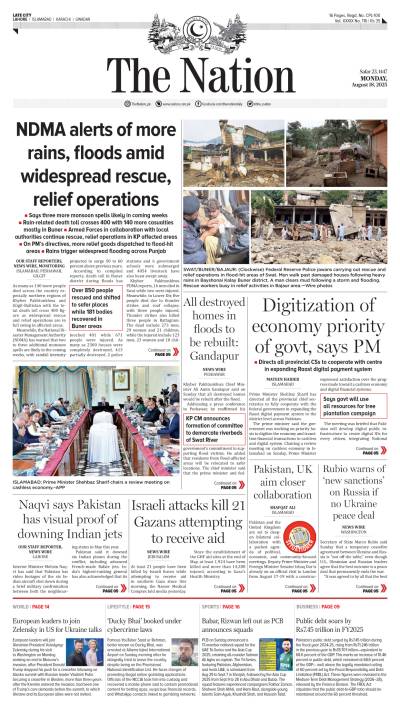ISLAMABAD - Absence of financing from both the central and the provincial (Punjab) government and refusal from the International Financial Institutions (IFIs) to finance rehabilitation and up gradation of Islam headworks have raised grave questions as the headworks reportedly pose a threat of serious damages in the event of high flood in the river. Islam barrage, located about six miles north-west of Hasilpur town, was constructed on river Sutlej during 1922-27 to irrigate vast area of 0.689 million acres in the defunct state of Bahwalpur and 0.7 million acres falling in Punjab as a component of Sutlej Valley Project initially for feeding Bahwal Canal (5,400 cusecs) and Qaim Canal (558 cusecs) on the left bank and Mailsi Canal (5,400 cusecs) on the right bank. Further, the command area of Bahawl canal is however composed of mostly braickish zone. The population benefiting from its canal system is nearly 0.20 million falling in Bahawalpur district. Well placed Official sources have informed that Islam headwork was in distress owing to aging, design deficiencies, constructional defects, hydraulic and mechanical problems, inadequate operation, maintenance and drastic changes in river morphology as a result of implementation of Indus Water Treaty of 1960. The major problem at the headwork was inadequate flood passage capacity of barrage in relation to flood intensities developed over a 100-year return period. They were of the view that the aging process along with inadequate/deferred maintenance had contributed to a general deterioration of different components of the structure. The consultants engaged in June 1998 to assess the general health of the infrastructure had declared the barrage to be unsafe and desired a priority attention for its safe operation. A former secretary irrigation Punjab and an expert on barrages on condition of anonymity said that after the functioning of Indus Water Treaty, in every September as dams in India filled with floodwaters then this floodwater reached in Bhawalpur area and played havoc. He further warned both the governments to avoid delay in rehabilitation of this barrage to avert the risk of barrage failure in future. He informed that after feasibility study of Islam headwork/barrage, detailed designs was prepared in 2008 to rehabilitate them after the recommendations of consultants but due to lack of interest, inefficiency at the government level and absence of confidence/trust of International Financial Institutions (IFIs) on present democratically elected government contributed a lot to postpone the rehabilitation of this much needed headwork/ barrage. However, it was the responsibility of the central and provincial government to mobilise and generate funds for the rehabilitation of this barrage, he added. However, Mian Israrul Haq, Chief Strategic Planning Irrigation Department (Punjab) while talking to TheNation has informed that World Bank (WB) has given verbal assurance for financing the rehabilitation of Islam headworks but it would be after rehabilitation of Jinnah barrage almost in 2011.He informed that WB had financed for the feasibility and design study of the barrage but rehabilitation of Islam headworks was out of their port folio as this year it was financing for Jinnah Barrage. He further commented that politics and lack of curiosity on the part of IFIs had postponed the fate of rehabilitation of Islam barrage to 2011. It is worth mentioning to note that suitable scheme needs to be chalked out for the safe passage of floodwaters as the barrage operation ran into difficulty soon after its construction in 1927. Even the geometry of existing training works is not adequate to face the design flood flow discharge in the river and the retired flood embankments needs massive up gradation and for safety assurance, provision of wetting channels along the river side is essential on the pattern of other barrages in Punjab. Moreover, the operation defects are now being experienced quite frequently on account of aging effects and deferred maintenance. The manual operation of the gates is also becoming quite cumbersome in the current environments. The renovation of the gates system and up gradation of support facilities is therefore immediately required. Again, the pressure pipes installed at barrage have mostly gone out of order or covered by road bridge deck after its reconstruction and widening. Both manual and automatic data acquisition system should be installed at the barrage to monitor the condition of subsoil flow and uplift pressure being exerted under the downstream floor.
Tuesday, August 19, 2025
Lack of funds threatens Islam Headworks
PMD forecasts heavy rain across Pakistan
8:56 AM | August 19, 2025
Cartoon
August 19, 2025
Hague Group’s Proposals
August 19, 2025
Historical Amnesia
August 19, 2025
Mafia in Nathia Gali
August 19, 2025
-
'No talk of President Zardari resigning or COAS seeking Presidency': Naqvi rejects rumours
-
'No talk of President Zardari resigning or COAS seeking Presidency': Naqvi rejects rumours
-
Pilgrims perform final Hajj ritual as Eidul Azha begins amid tight security and heat measures
-
Hajj 2025 sermon: Imam-e-Kaaba prays for Palestine, urges unity and compassion
-
Nearly 2 million Muslim pilgrims ascend Mt Arafat for climax of Hajj pilgrimage
-
How the US repeatedly failed to deliver aid to the people of Gaza
Digital Leap
August 18, 2025
Unmasked Complicity
August 18, 2025
A New Kick-Off
August 18, 2025
Drowning in Denial
August 17, 2025
A Fragile Peace
August 17, 2025
Admissions Crisis in Punjab
August 18, 2025
Poultry Mafia
August 18, 2025
Prevention Over Cure
August 18, 2025
Olympics 2028
August 17, 2025
Alarming Rise in Youth Unemployment
August 17, 2025
ePaper - Nawaiwaqt
Nawaiwaqt Group | Copyright © 2025







